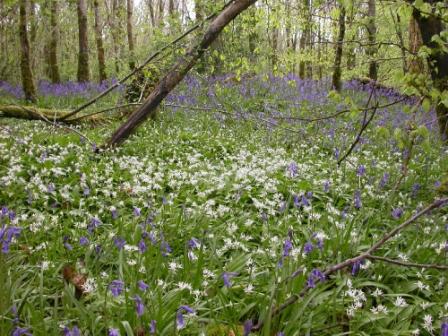
Bluebells and Wild Garlic
Of all our wild habitats, native woodland should really rate as the prime one. It’s what covered most of the land before the coming of agriculture, and it supported and evolved along with much of our wildlife. The few scraps that remain are the key to both past and future. Although these ancient woods are often known as Oakwoods, it’s not always Oak trees that predominate. Depending on height above sea level and on the depth, acidity and dampness of the soil, other species such as Ash or Birch or Alder can take a leading role, but in our oldest woods it’s usually the Oaks that form the main part of the leafy canopy. And, of course, any native woodland is about a lot more than the trees. About two-thirds of breeding land-birds, more than half of our moths, and a sixth of our flowering plants are all more or less dependent on woodland. You also find a fantastic variety of mosses and ferns and lichens – exuberant green life cloaking every surface and filling every space.
Some of our best wildwood remnants still cling on in remote hillside glens which are far off the beaten track, but in Donegal we also have some great examples which are now protected areas and which anyone can visit. Glenveagh National Park, Ardnamona at Lough Eske, Duntally Wood at Creeslough, Rathmullan Wood and parts of Ards Forest Park all contain excellent woodland habitat, and each has its own unique atmosphere. At Glenveagh you find the gnarled and stunted Oaks of upland areas, while in Ardnamona they have huge straight trunks with long limbs stretching wide.
The wonderful floral carpet in many of our woods is one of the big highlights of spring. Early flowers tend to come in large clumps or wide sheets, at a time when they don’t have too much competition from other plants, and under a woodland canopy they need to get the serious business of blooming completed before the leaves overhead block out the light. The spring flowering comes in two main waves. Early May sees Wood Anemone in full bloom, along with Celandine, Wood Sorrel and Golden Saxifrage. Wood Anemone spreads itself mostly by its underground root network, but it does this so slowly that if you come across a wide area of its graceful nodding heads, you can be sure that you’re looking at ancient woodland.
Towards the end of the month it will be the turn of the Bluebells and Ramsons (Wild Garlic). Bluebells are so well-known that we think of them as common plants but, in fact, they are a real specialty of Ireland and Britain and people travel long distances to experience that brilliant blue mist spreading away through the trees. Ramsons with their lovely sprays of white star-like florets tend to go for the shadier corners of the wood, while the Bluebells thrive best in dappled light. Bugle, Sanicle, Pignut and Sweet Woodruff are all indicators of long woodland cover.
Most woodland birds can turn up anywhere along the hedgerows, and many are familiar around the garden, but there are a couple of specialists which are not so well-known and are well worth looking out for. Jays are members of the Crow family, but this Crow comes in full colour! It has an unusual pinkish plumage, with striped crown, black moustache, and a bright blue flash on the wing which shows up best in flight. Ireland has its own sub-species of Jay which tends to be darker than the British and Continental races.
The Treecreeper has adapted its habits so completely to living on the trunks and branches of mature trees that you rarely see one anywhere else. It looks just like a little mouse scuttling up a tree, often spiraling around the trunk or running upside down along the undersides of branches. Its streaky buff and brown back acts as a perfect camouflage, but now and again you can get a glimpse of its silky-white breast. Its whole body is designed for prising food items out of crevices in the bark - large feet with sharp claws help it cling on tightly, stiff tail feathers brace the body against the tree to get more leverage, but most of all, the long curved beak with needle-point can pick the tiniest mite from the tightest crack.
In a natural woodland more than half of the timber at any one time is likely to consist of fallen trees and branches, and occasional dead trees still standing. Lots of different insects and all sorts of mini-beasts base part or all of their lifestyle on rotting wood, and many species of lichen, moss and fungus take advantage of it as well. The dead wood community is a vital part of the whole wildlife web. A fallen tree also makes a window in the wood, letting in light and allowing other plants to thrive on the forest floor. Given time, seedling trees will spring up to fill the space.
Four to Find this Month:Violets: These come in various species. Common Dog Violet is a woodland plant, also found on heathland and rocky pasture, but probably most familiar peeping out along grassy hedge banks. |